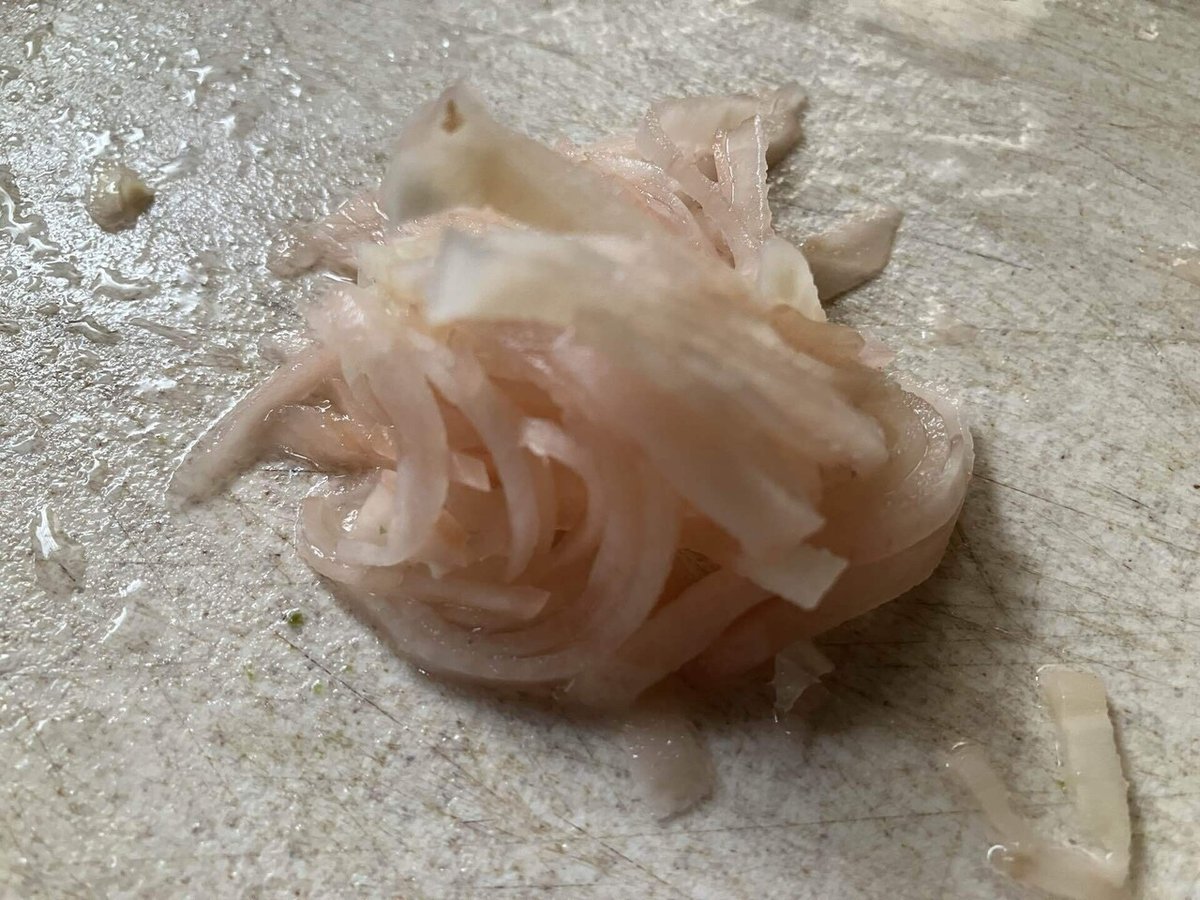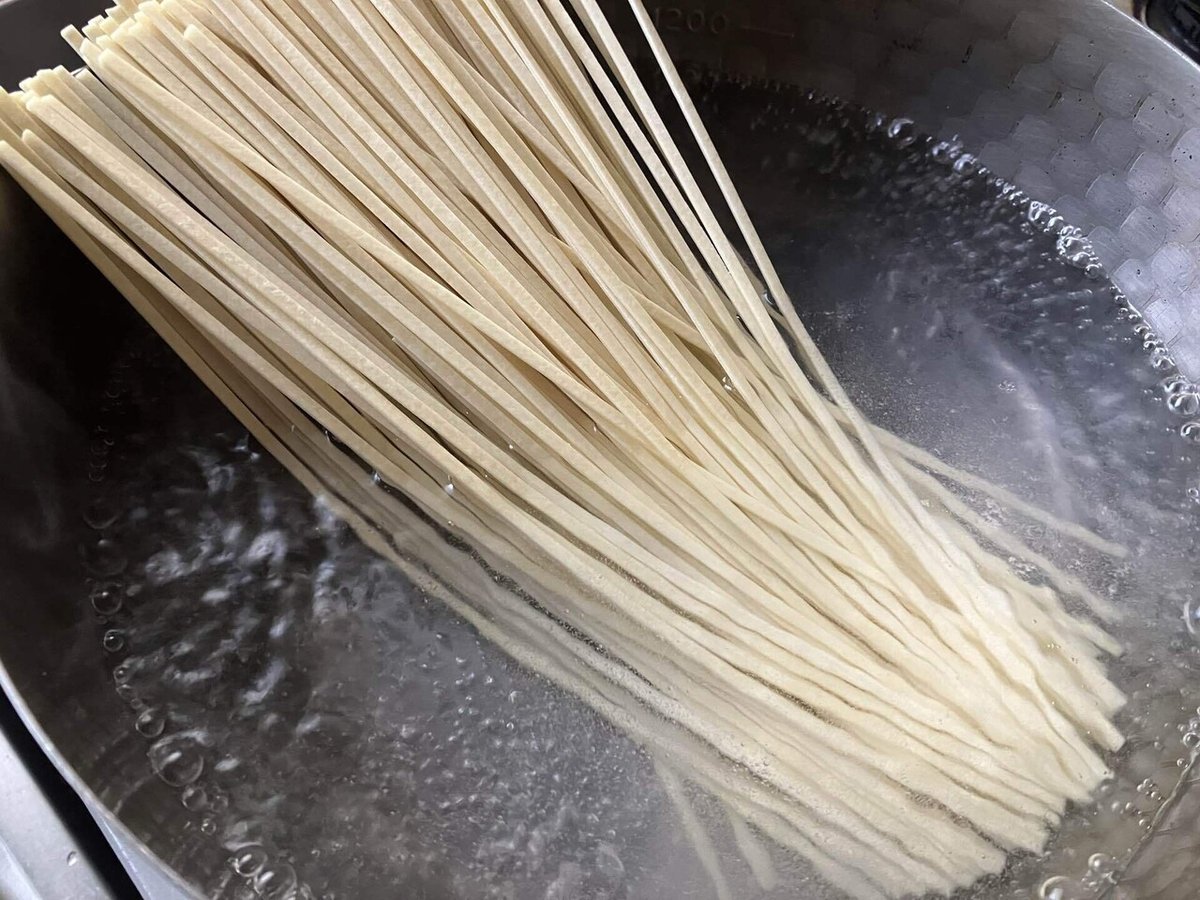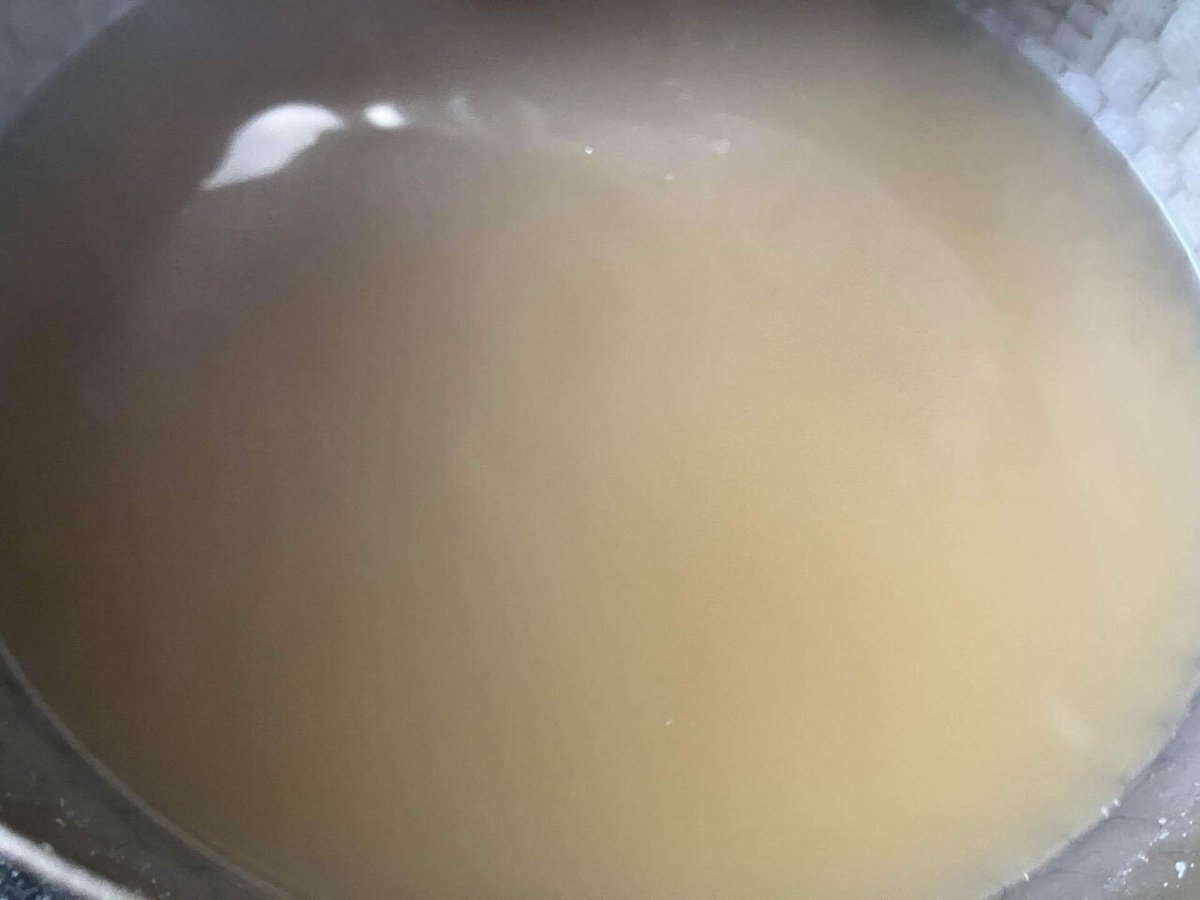
自家製ラフテーと丸カマボコで作る沖縄そば Okinawa soba made with homemade rafute and homemade round kamaboko
中華乾麺千本ノック 1000 fungos for Chinese dried noodles
世界的に見れば、スパゲッティや米麺など乾燥麺は市民権を得ているのに、日本で食べられている中国麺はほとんどが生タイプだ。インスタントヌードルは日本の発明だけど、スナック扱いされていて、正式な食事の席では喜ばれない。だから、あえて中華乾麺頑張れというお話し。安いし冷蔵の電気代かからないからね。
Globally, dried noodles such as spaghetti and rice noodles have gained popularity, but most Chinese noodles eaten in Japan are fresh. Instant noodles are a Japanese invention, but they are treated as snacks and are not welcomed at formal dinner tables. That's why I'm urging Chinese dried noodles to do their best. They're cheap and don't require electricity for refrigeration.
ストーリー
Recipe trivia
以前、ソーミンチャンプルーの記事を書いたときに触れたが、沖縄の麺料理の歴史はさほど長くはない。中国料理に大きな影響を受けていた琉球の宮廷料理人たちは、当然麺料理にも精通していたとは思うが、小麦粉の流通のなかった当時の沖縄では一般化はしなかったようだ。薩摩藩との交易が頻繁になって、九州から纏まった量の小麦粉が持ち込まれるまれてから沖縄でも徐々にソーミン(素麺)やヒラヤチー(沖縄風のお好み焼き)が家庭料理にも取り込まれていった。ただ、今ではすっかり沖縄のソウルフードになった現在の「沖縄そば」の誕生は、さらに時代を下り、第二次世界大戦後になる。ラーメン自体は、明治の後期に日本や沖縄にも中国系の料理人が住むようになって、「支那そば」として紹介はされてはいた。ただ、それはあくまでも中国料理としてだった。戦後、中国からの帰還者が専門店を開いたのが、今の沖縄化した「沖縄そば」の始まりだ。同じ「支那そば」から発展して土着化したという意味で、沖縄そばは、一見別物に見える日本のラーメンと、実は兄弟なのだ。
面白いのは、土着の食文化と融合して発展する方向性が、沖縄そばと日本のラーメンでは大きく違っていた点だ。沖縄には、もともと豚で出汁を取る文化があり、同時に昆布や鰹節を使う文化も、沖縄の宮廷料理人が江戸時代に日本から取り入れていた。当時、今の沖縄料理の出汁の基本である「琉球出汁=豚出汁+鰹出汁」の原型はすでに完成していた。だから、この琉球出汁に中国から帰還者が持ち帰った「かん水麺(かん水や灰汁を入れて打つ中国式の小麦麺)」が結びつくのは必然だったのだと思う。これに対して、日本本土では当時、動物由来の出汁は一般的ではなかった。日本本土の庶民に一般的だった煮干しや鰹節の出汁では「かん水麺」には物足りなかったのだろう。うどんつゆや蕎麦つゆに「かん水麺」を入れるようなものだからだ。だから、日本本土の料理人は豚骨や鶏ガラで出汁をとり、隠し味に煮干しを足す方向でラーメンスープを完成させていった。名称も、沖縄では「黒い日本の蕎麦(蕎麦粉のそば)」に対する「沖縄そば」が定着し、日本固有の蕎麦粉のそばと紛らわしい「支那そば」の名称は日本本土では「ラーメン」に置き換えられていったと思われる。
As I mentioned in my previous article on somin chanpuru, the history of noodle dishes in Okinawa is not that long. The chefs of the Ryukyu Imperial Court, who were heavily influenced by Chinese cuisine, were naturally familiar with noodle dishes, but it seems that they did not become common in Okinawa at that time, when wheat flour was not in circulation. After trade with the Satsuma Domain became frequent and a large amount of wheat flour was brought in from Kyushu, somin (somen noodles) and Hirayachi (Okinawan-style okonomiyaki) were gradually incorporated into home cooking in Okinawa. However, the birth of the current "Okinawa soba," which has now become Okinawa's soul food, took place even later, after World War II. Ramen itself was introduced as "Shina soba" when Chinese chefs began to live in Japan and Okinawa in the late Meiji period. However, it was only as a Chinese dish. After the war, Chinese returnees opened specialty shops, which marked the beginning of the "Okinawa soba" that has become Okinawan in the present day. In the sense that it developed from the same "Shina soba" and became indigenous, Okinawa soba is actually a brother of Japanese ramen, which at first glance seems to be a different thing.
What's interesting is that the direction in which Okinawa soba and Japanese ramen developed through fusion with indigenous food culture was very different. Okinawa originally had a culture of making soup stock from pork, and at the same time, the culture of using kelp and bonito flakes was also adopted from Japan by Okinawan court chefs during the Edo period. At that time, the prototype of "Ryukyu soup stock = pork stock + bonito stock," which is the basis of the soup stock in modern Okinawan cuisine, was already complete. Therefore, I think it was inevitable that this Ryukyu soup stock would be combined with "kansui noodles (Chinese-style wheat noodles made with kansui and lye)" brought back by returnees from China. In contrast, animal-based soup stock was not common in mainland Japan at that time. The soup stock made from dried sardines and bonito flakes, which was common among ordinary people in mainland Japan, was probably not enough for "kansui noodles." It's like putting "kansui noodles" in udon soup or soba soup. Therefore, chefs in mainland Japan made ramen soup by making soup stock from pork bones and chicken carcasses and adding dried sardines as a secret ingredient. As for the name, "Okinawa soba" became established in Okinawa as a counterpoint to "black Japanese soba (buckwheat flour soba)," and the name "Shina soba," which could be confused with soba made from buckwheat flour that is unique to Japan, was replaced by "ramen" in mainland Japan.
麺の上にトッピングする具についても、沖縄と日本本土では大きな違いが見られる。
豚のばら肉を煮たラフテーや肋肉を煮たソーキが元々琉球料理には存在し、琉球出汁と一緒に食べる文化もあったので、沖縄そばにも、自然と取り入れられた。チキアギ(つけ揚げ、琉球かまぼこ。日本本土でいうところの琉球揚げ、薩摩揚げ)も一般的な食材だった。つまり、琉球料理にすでに存在していた汁物や食材と中華麺の組み合わせが、沖縄そばの原型となっている。
日本本土には、そういった中華麺に合わせるような既存の素材は見出しにくく、焼豚や煮豚がラーメン専用の具材として開発された。かまぼこは採用されたが、沖縄のように揚げかまぼこ(チキアギ)ではなく、蒸した鳴門かまぼこだったりする。
その後は、どちらも、創意工夫が加えられ、独自の発展の道を歩んで行ったのは、ご存じの通りだ。
一般的に、食文化が土着化して行く過程には二つのパターンが見られる。一つは、渡来した料理の要素が、元々あった土着の料理に取り入れられ、統合されるというパターンだ。沖縄そばはこれの典型例だ。琉球出汁のスープを食べる琉球の食文化に、中華麺が取り込まれて行った。そうして「沖縄そば」が生まれた。もう一つは、渡来した料理が、土着の食文化に新カテゴリーとして加えられ、その食文化に馴染むように変容して行くパターンだ。日本本土のラーメンはこれの典型例。支那そばという中国料理が日本料理の新カテゴリーとして土着化し、日本的な変容が加えられて、中華料理とは違う独自の「ラーメン」というジャンルが確立された。
There are also big differences between Okinawa and mainland Japan in the toppings on the noodles.
Rafute, stewed pork belly, and soki, stewed rib meat, were originally found in Ryukyu cuisine, and there was a culture of eating them with Ryukyu broth, so they were naturally incorporated into Okinawa soba. Chikiagi (tsukeage, Ryukyu kamaboko, known in mainland Japan as Ryukyu age or satsuma age) was also a common ingredient. In other words, the combination of soups and ingredients that already existed in Ryukyu cuisine with Chinese noodles became the prototype of Okinawa soba.
In mainland Japan, it was difficult to find existing ingredients that went well with such Chinese noodles, so roast pork and boiled pork were developed as ingredients specifically for ramen. Kamaboko was adopted, but it was not deep-fried kamaboko (chikiagi) like in Okinawa, but steamed Naruto kamaboko.
After that, both were given creative ingenuity and went on their own paths of development, as you know.
Generally speaking, there are two patterns in the process by which food culture becomes indigenous. One is when elements of introduced cuisine are adopted and integrated into the existing indigenous cuisine. Okinawa soba is a typical example of this. Chinese noodles were incorporated into the Ryukyuan food culture of eating soup made from Ryukyu stock. This is how "Okinawa soba" was born. The other is when an introduced cuisine is added to an indigenous food culture as a new category and is transformed to fit into that food culture. Ramen in mainland Japan is a typical example of this. A Chinese dish called Shina soba became indigenous as a new category of Japanese cuisine, and was transformed in a Japanese way, establishing the unique genre of "ramen" that is different from Chinese cuisine.
今回は、基本の具であるラフテーと丸かまぼこ(棒かまぼこ)を自家製するところから始める。紅生姜も自家製する。丸かまぼこには、グルクンなんかを使いたいところだけど、沖縄でも、最近は県産の魚ではなく、スケソウダラを取り寄せて使っているそうなので、いつも使っている白身魚のパンガシウス(鯰の近縁種)を使った。
そして肝心の沖縄麺。僕は、沖縄麺は普段は手打ちをしている(沖縄麺は、生麺を買うととんでもなく高いので、手打ちするようになった。都内の沖縄料理屋で沖縄そばにこだわるところは、自家製麺している。沖縄から取り寄せると原価がとんでもなく上がってしまうからだ)。ただ、今回はあえて乾麺を使ってみた。残念だけど、沖縄で作られている乾麺には美味しいものがない。沖縄では生麺の製麺が盛んに行われているので、乾麺はあまり追求されていないように思える(最近は沖縄に行っておらず、僕のリサーチ不足かもしれないので、もし美味しくてリーズナブルな沖縄乾麺があったら、ご教示いただけると嬉しいです)。沖縄そば用に作られた乾麺ではないのだけど、非常に沖縄の平打ち麺に食感の近い美味しい乾麺があったので、今回はそれを使った。「はくばく」という山梨県の製麺会社の製品だ。
手元に「あおさ」があったので、それもトッピングして、「アーサそば」になった。
This time, I started by making the basic ingredients, rafute and kamaboko (fish cake). I also made my own pickled ginger. I would have liked to use gurukun for the kamaboko, but I heard that in Okinawa, they are now using Alaska pollock instead of fish from the prefecture, so I used the white fish I always use, pangasius (a close relative of catfish).
And the most important thing, the Okinawan noodles. I usually make Okinawan noodles by hand (I started making them by hand because buying fresh noodles is so expensive. Okinawan restaurants in Tokyo that specialize in Okinawa soba make their own noodles because the cost of ordering them from Okinawa is so high). However, this time I decided to use dried noodles. Unfortunately, there are no tasty dried noodles made in Okinawa. In Okinawa, where fresh noodle making is popular, dried noodles don't seem to be pursued very much (I haven't been to Okinawa recently, so it may be that I haven't done enough research, but if you know of any tasty and reasonably priced dried Okinawan noodles, I would be grateful if you could let me know). Although they are not dried noodles made for Okinawa soba, I found some tasty dried noodles that have a texture very similar to Okinawa's flat noodles, so I used them this time. They are a product of a noodle manufacturer in Yamanashi Prefecture called "Hakubaku."
I had some green laver on hand, so I added that as well as topping it, making "Aasa(green laver) Soba."
Ingredients:
材料:
中華乾麺(平打ち麺)
自家製のスーチカ(塩漬け豚ばら肉。市販品でも良い。皮付きのものが手に入るなら尚可)※
白身魚(パンガシウス。タラなど他の白身魚でも良い)
新生姜
あおさ
博多ネギ(ワケギや九条ネギでも)
昆布
鰹削り節(ここでは、花粉を使用)
上白糖
黒糖
米酢
泡盛
九州醤油
酸化しにくい油
※レシピは以前の記事を参照。
Chinese dried noodles (flat noodles)
Homemade souchka (salted pork belly, or store-bought, even better if you can get it with the skin on)*
White fish (Pangasius. Cod or other white fish will do)
Fresh ginger
Green laver
Hakata leek (you can also use scallions or Kujo leek)
Kelp
Dried bonito flakes (we use very fine flakes here)
White sugar
Brown sugar
Rice vinegar
Awamori (Okinawa Spirits)
Kyushu soy sauce
Oil that does not oxidize easily
*See previous post for recipe.
procedure:
手順:
(紅生姜を作る)
新生姜をスライサーで薄くスライスする。必ず赤い芽の部分も一緒にスライスすること。
米酢に上白糖で好みの甘みを付けた漬け込み液を用意する。
スライスした新生姜を漬け込み液に漬け、消毒した瓶などで冷暗所に保存する。
2、3日目から使える。常温で長期の保存が可能。
(Making pickled ginger)
Thinly slice the fresh ginger using a slicer. Be sure to slice the red buds as well.
Prepare a pickling liquid by mixing rice vinegar with white sugar to taste.
Pickle the sliced fresh ginger in the pickling liquid and store in a sterilized jar in a cool, dark place.
Can be used from the second or third day. Can be stored at room temperature for a long time.




(ラフテーと豚出汁を作る)
スーチカを四角いブロックに切り出す。
厚手の鍋にカットしたスーチカを入れて水を注ぎ、加熱する。スープに使うので、少し多めの水加減にする。沸騰したら、弱火にして、2時間半茹でる。圧力鍋を使うと45分に短縮できる。
流水などで、鍋ごと冷やして、肉とスープを分けて、冷蔵庫に一晩保管する。
スープの上に固まったラードを取り除く。ラードは炒め物に使うと良い。できたスープ(豚出汁)の8割は沖縄そば用に取り置く。スープは4日程度冷蔵保存可能。
豚出汁の2割を厚手の鍋に入れ、取り置いてあった肉を入れる。泡盛と九州醤油、黒糖、鰹削り節(不織布に入れると取り出すのが簡単)を入れ、キッチンペーパーやアルミホイルなどで落とし蓋をし、中火で煮込む。水分が無くなってきたら火を止め、そのまま放冷する。
冷めたら、崩れないよう、フライ返しなどで、丁寧に取り出して、冷蔵庫で冷やす。冷やすと、綺麗に切ることができる。
すぐに使わない場合は冷蔵庫で1週間程度保存が可能。
豚出汁もラフテーも、さまざまな沖縄料理に使うことができる。
Cut the suchika into square blocks.
Put the cut suchika in a thick-bottomed pot, pour in water, and heat. Use a little more water than necessary as this will be used in the soup. Once boiling, reduce heat to low and simmer for 2.5 hours. If you use a pressure cooker, you can reduce this to 45 minutes.
Cool the pot under running water, separate the meat and soup, and store in the refrigerator overnight.
Remove the solidified lard on top of the soup. You can use the lard for stir-frying. Reserve 80% of the finished soup (pork stock) for the Okinawa soba. The soup can be refrigerated for about 4 days.
Put 20% of the pork stock into a thick-bottomed pot and add the reserved meat. Add awamori, Kyushu soy sauce, brown sugar, and bonito flakes (it's easier to remove them if you put them in non-woven fabric), cover with a paper towel or aluminum foil, and simmer over medium heat. When the water has evaporated, turn off the heat and leave to cool.
Once it has cooled, carefully remove it with a spatula so that it does not crumble, and chill in the refrigerator. Once chilled, it can be cut neatly.
If you are not going to use it right away, you can store it in the refrigerator for about a week.
Both the pork stock and rafute can be used in a variety of Okinawan dishes.






(丸かまぼこを作る)
白身魚(フィレでない場合は、骨や皮、血合を取り除く)を適当な大きさにカットする。
フードプロセッサーに魚の切り身、塩、黒糖(白く仕上げたいなら上白糖)、片栗粉を入れ、魚のすり身を作る。
油を鍋に入れて、摂氏160度まで加熱しておく。
手に油を付けて、すり身を団子に丸め、油を塗ったまな板の上などで、転がして、棒状に成形する。
加熱した油に、静かに滑り込ませて、じっくり揚げる。冷たい材料が入ると油の温度が下がるので、160度近辺の油温を保つよう、火加減を調節すること。火が入ると倍の大きさに膨れるので、入れすぎないように注意する。
倍に膨れ上がって、揚げ色がついてきたら、油を切って冷ます。
冷蔵庫で1週間程度の保存が可能。
琉球揚げ(薩摩揚げ)については以前の記事で細かい説明をしたので、よければ、参考にしてください。
(Make round kamaboko) Cut the white fish (if it is not filleted, remove the bones, skin and blood) to bite size pieces. Put the fish fillets, salt, brown sugar (or white sugar if you want a whiter finish), and potato starch in a food processor to make the fish paste. Put oil in a pan and heat to 160 degrees Celsius. Wet your hands with oil and roll the paste into balls, then roll them on an oiled cutting board to form them into rods Gently slide the balls into the heated oil and deep fry slowly. The temperature of the oil will drop when cold ingredients are added, so adjust the heat to keep the oil temperature around 160 degrees. The fish will double in size when cooked, so be careful not to put in too much. When it has doubled in size and has started to brown, drain the oil and cool. It can be stored in the refrigerator for about a week. I have explained Ryukyu Age (Satsuma Age) in detail in a previous article, so please refer to it if you like.






(鰹出汁を取る)
鍋に昆布を入れ、水を注いで、加熱する。
沸騰したら、鰹節削りを入れて、十分くらい弱火で煮る。
鰹削り節と昆布を取り出す。取り出した出汁ガラからは二番出汁が取れるし、昆布と鰹節で佃煮も作れるので、捨てない。
(Making bonito stock)
Put kelp in a pot, pour in water, and heat.
When it boils, add shaved bonito flakes and simmer over low heat for about ten minutes.
Remove the shaved bonito flakes and kelp. Don't throw them away, as you can make a second stock from the removed stock bones and you can also make tsukudani with the kelp and bonito flakes.

(沖縄そばを作る)
ラフテーと丸かまぼこは、トッピング用にスライスしておく。
博多ネギは刻んでおく。
紅生姜は、水気を絞って千切りにしておく。
あおさは、乾燥の場合は、水で戻しておく。
鍋にお湯を沸かして、中華乾麺をゆでる。茹で汁で丼を温めておく。
鍋に、豚出汁と鰹出汁を入れて、加熱し、九州醤油で味付けをする。好みで、黒糖を加えても良い。
丼に茹で中華麺を入れる。
そこに味付けしたスープを注ぐ。
用意した具をトッピングする
(Making Okinawa soba)
Slice the rafute and kamaboko fish cakes for topping.
Chop the Hakata leeks.
Squeeze the pickled ginger and cut it into thin strips.
If the green laver is dried, soak it in water.
Bring water to a boil in a pot and boil the dried Chinese noodles. Warm a bowl with the cooking water.
Put pork stock and bonito stock in the pot, heat, and season with Kyushu soy sauce. You can add brown sugar if you like.
Put the boiled Chinese noodles in a bowl.
Pour the seasoned soup over.
Top with the prepared ingredients.













Tips and tricks:
コツと応用のヒント:
紅生姜は、新生姜の持つ赤い色素(アントシアニン)を利用しているので、薄いピンクの仕上がりになっている。ひね生姜だと、この色は出ない。市販品のように赤くしたい場合は、食紅を使う。常温保存でき、いろんな用途に使えるので、新生姜の時期にまとめて作っておくと良い。
Pickled ginger has a light pink finish because it uses the red pigment (anthocyanin) that young ginger contains. This color does not appear if the ginger has been harvested for a long time. If you want to make it red like the commercially available product, use food coloring. It can be stored at room temperature and can be used for various purposes, so it is a good idea to make a large batch in the young ginger season.
塩漬けでない豚バラ肉は油がしつこく、同じ仕上がりにならない。
沖縄では、皮付きの豚バラ肉が使われるので、手に入るなら、その方がより本格的。
冷やさないできると、崩れてしまい、綺麗な切り口にならない。
風味は少し違うが、泡盛がない場合は、焼酎や日本酒で代用しても良い。
まとめて仕込んでおくと、沖縄料理、中華料理、ラーメンなどにも使えるので、便利。
Unsalted pork belly has a heavy oiliness and will not produce the same finish. It is better to salt it before using it if possible.
In Okinawa, pork belly with the skin on is used, so if you can get it, that is more authentic.
If it is not cooled, it will fall apart and you will not be able to get a nice cut.
If you do not have awamori, you can use shochu or sake instead, although the flavor will be a little different.
It is convenient to prepare and cook it in bulk, as it can be used for Okinawan cuisine, Chinese cuisine, ramen, etc.
沖縄かまぼこ(チキアギ)は、伝統的には揚げて作るが、蒸しても良い。ただ、あげた方が長持ちする。
ここでは、切り口が茶色っぽいが、黒糖を使っているため。上白糖を代わりに使えば、白い切り口になる。
保存性が良いので、いろんな形に成形して多めに作っておけば、普通の薩摩揚げとして、いろいろな用途に使える。沖縄おでんに入れれば、本格的。
Okinawa kamaboko (chikiagi) is traditionally deep-fried, but it can also be steamed. However, it lasts longer if it is deep-fried.
Here, the cut surface looks brownish, but that is because brown sugar is used. If you use white sugar instead, the cut surface will be white.
It keeps well, so if you make it in large quantities and shape it into various shapes, it can be used for various purposes as regular satsuma-age. Add it to Okinawan oden for an authentic taste.
沖縄そばの出汁は、しっかりした豚出汁に鰹節の香りがブレンドされて生まれる。しっかり鰹節の香りが立つよう、鰹節は多めに使った方が、本格的な味になる。
関東の濃口醤油は辛すぎて酸味も強いので、沖縄料理には向かない。できれば九州か沖縄の少し甘めのしょうゆを使うと良い。普通の濃口醤油を使う場合は、控えめに使い、黒糖を少し多めに入れると良い。
これは、基本の作り方。最近の沖縄そばは、日本のラーメンと同じく、ニューウェーブが次々に生まれているので、、ここから始めて、いろいろなバリエーションを楽しむと良い。
Okinawa soba broth is made by blending strong pork stock with the aroma of bonito flakes. Using more bonito flakes will give the dish a more authentic taste so that the bonito aroma really stands out.
Kanto dark soy sauce is too spicy and sour, so it's not suitable for Okinawan cuisine. If possible, use a slightly sweeter soy sauce from Kyushu or Okinawa. If you use regular dark soy sauce, use it sparingly and add a little more brown sugar.
This is the basic recipe. Just like Japanese ramen, new waves of Okinawa soba are emerging one after another these days, so start here and enjoy the various variations.
Guide to where to get ingredients and equipment 材料と機材の入手先ガイド
※Amazonのアフェリエイトに参加しています。もしご購入の際はここからクリックしてご購入いただけると、コーヒー代の足しになるので、嬉しいです。ちなみに僕はコーヒー依存症です。
*I participate in Amazon affiliate programs. If you purchase this product by clicking here, it will help pay for my coffee, so I would be very happy. By the way, I am addicted to coffee.
この記事が参加している募集
この記事が気に入ったらサポートをしてみませんか?

